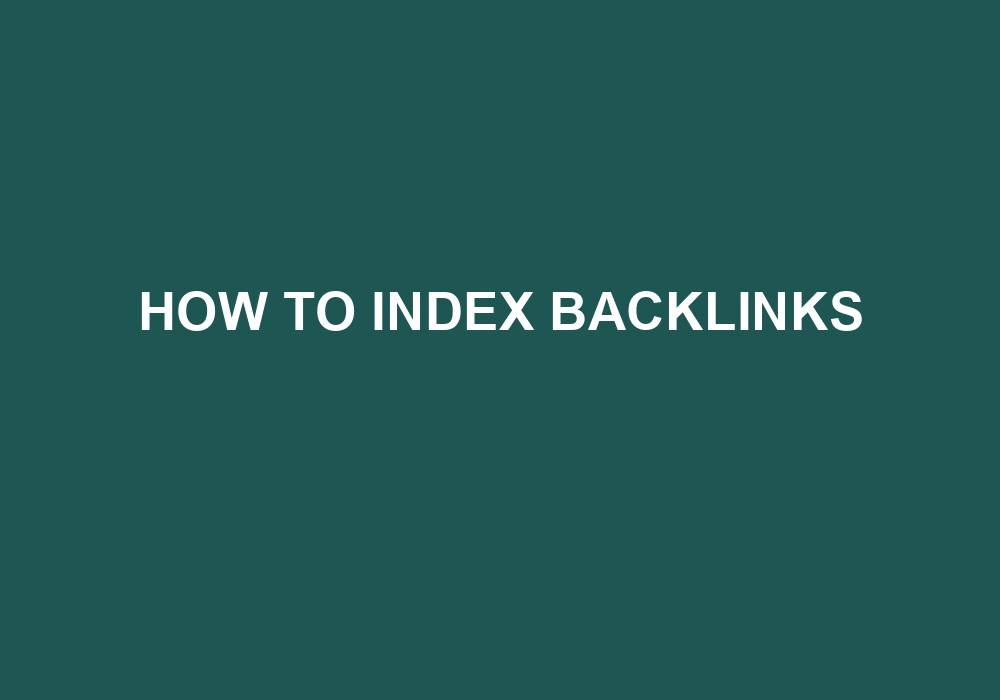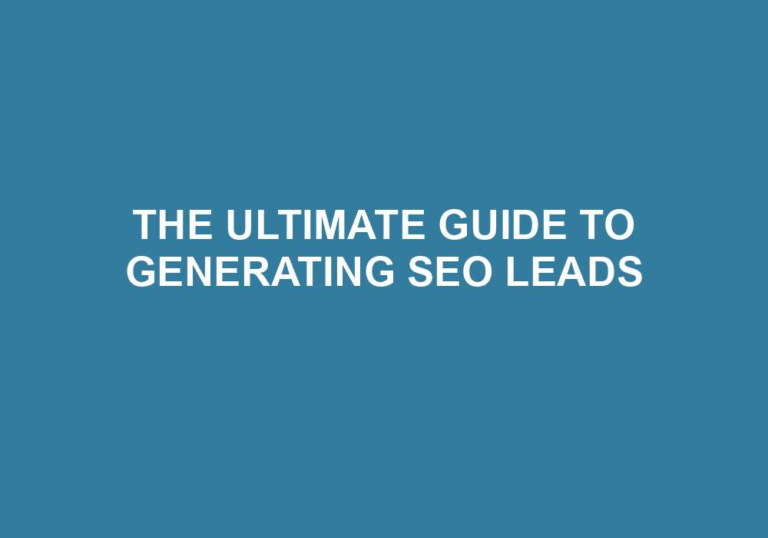In the ever-evolving world of SEO, backlinks play a crucial role in determining the credibility and visibility of a website. As a website owner or digital marketer, you may have spent countless hours building a strong backlink profile, carefully selecting reputable sources and creating high-quality content. However, even with all the effort put into acquiring backlinks, their true impact can be hindered if they are not properly indexed by search engines. This is where the art of indexing backlinks comes into play – a skill that can greatly enhance your website’s ranking potential and organic traffic. In this comprehensive guide, we will delve into the world of indexing backlinks, exploring proven strategies and techniques to ensure your backlinks are discovered and recognized by search engines, ultimately boosting your website’s visibility and authority in the vast digital landscape.
Before diving into the intricacies of indexing backlinks, it is essential to understand the significance of this process. Backlinks act as digital endorsements, vouching for the quality and relevance of your website’s content. However, search engines cannot automatically recognize every backlink pointing to your site, potentially undermining the efforts you have invested in building a robust backlink profile. This is where indexing comes into play – a process that notifies search engines about the existence and relevance of your backlinks, allowing them to be counted towards your website’s overall ranking. By mastering the art of indexing backlinks, you can ensure that your hard-earned backlinks receive the recognition they deserve, ultimately propelling your website to new heights in search engine result pages. So, let’s embark on this journey together, unraveling the secrets of indexing backlinks and reaping the rewards of enhanced visibility and organic traffic.
How to Index Backlinks:
- Create an XML sitemap of your website with all the backlink URLs included.
- Submit the sitemap to Google Search Console.
- Ensure the backlinks are from reputable and relevant websites.
- Promote the backlinks through social media and other channels.
- Monitor the indexing progress using Google Search Console.
How to Index Backlinks
Welcome to this step-by-step guide on how to index backlinks. In order to improve the visibility and ranking of your website, it is crucial to ensure that search engines are aware of the backlinks pointing to your site. By indexing these backlinks, you can maximize their impact and increase your chances of ranking higher in search engine results. In this article, we will walk you through the process of indexing backlinks effectively, using proper HTML headings and techniques.
Step 1: Understanding the Importance of Indexing Backlinks
Before we dive into the details of indexing backlinks, it is essential to understand why this process is important. Backlinks are a key factor in determining the authority and relevance of your website in the eyes of search engines. When search engines recognize high-quality backlinks pointing to your site, they are more likely to view your content as trustworthy and valuable, which can lead to higher rankings. However, if search engines are not aware of these backlinks, they cannot attribute their value to your website. That’s where indexing comes in.
Indexing backlinks involves notifying search engines about the existence and location of these backlinks, allowing them to crawl and index the pages where they are found. By ensuring that search engines are aware of your backlinks, you increase the chances of them being taken into account during ranking algorithms.
Step 2: Leveraging HTML Headings for Better Indexing
HTML headings play a crucial role in organizing and structuring your content. They also provide search engines with important signals about the relevance and hierarchy of the information on your page. When it comes to indexing backlinks, utilizing proper HTML headings can help search engines understand the significance of these links and prioritize their crawling and indexing.
When creating HTML headings, it is important to use the appropriate heading tags, such as H1, H2, H3, etc. Each heading tag represents a different level of importance, with H1 being the most important and H6 being the least important. By using H2 and H3 headings, you can effectively divide and categorize your content, making it easier for search engines to recognize and understand the context of your backlinks.
Step 3: Implementing Proper HTML Headings for Backlink Indexing
Now that you understand the significance of indexing backlinks and leveraging HTML headings, let’s dive into the implementation process. Here are the steps to follow:
Step 3.1: Identify the pages where your backlinks are located. This could be external websites, guest posts, or any other source linking to your site.
Step 3.2: Open the HTML source code of the page containing the backlink. You can do this by right-clicking on the page and selecting “View Page Source” or a similar option.
Step 3.3: Locate the section of the HTML code that corresponds to the backlink. This can typically be found within an anchor tag (<a>) with the href attribute pointing to your website.
Step 3.4: Surround the relevant HTML code with an appropriate heading tag, such as <h3>. This will indicate to search engines that the content within this tag is important and relevant.
Step 3.5: Repeat steps 3.2 to 3.4 for each backlink you want to index.
By following these steps and implementing proper HTML headings, you can effectively index your backlinks and improve the visibility and ranking of your website. Remember to regularly monitor the indexing status of your backlinks and make necessary adjustments if needed. With consistent effort and optimization, you can harness the power of indexed backlinks to drive organic traffic and boost your online presence.
Frequently Asked Questions
In this section, we have compiled some commonly asked questions about how to index backlinks. If you have any queries regarding the process of indexing backlinks, this FAQ section will provide you with the necessary information.
What is indexing backlinks?
Indexing backlinks refers to the process of getting search engines to recognize and include your backlinks in their index. When you build backlinks, they need to be indexed by search engines to have any impact on your website’s search visibility. Without indexing, search engines won’t be able to recognize and credit your backlinks.
To index backlinks, you can use various methods like submitting them to search engines directly, using social bookmarking sites, or utilizing indexing services. These methods help search engines discover and crawl your backlinks, ensuring they are recognized and considered for ranking purposes.
Why is it important to index backlinks?
Indexing backlinks is crucial for improving your website’s search engine rankings. When search engines index your backlinks, they give more weightage and authority to your website. Indexed backlinks are considered as credible signals, indicating that your website is trustworthy and relevant to search queries.
Without indexing, your backlinks may remain invisible to search engines, resulting in missed opportunities to improve your website’s visibility and organic traffic. By indexing your backlinks, you maximize their potential to positively impact your website’s search rankings.
How long does it take to index backlinks?
The time it takes for backlinks to get indexed can vary. While some backlinks may get indexed within a few hours, others might take several days or even weeks. It depends on various factors like the authority of the linking website, the frequency of search engine crawls, and the indexing methods used.
To expedite the indexing process, you can take proactive steps like building high-quality backlinks from authoritative websites, regularly updating your sitemap, and submitting your backlinks to search engine webmaster tools. Additionally, promoting your backlinks through social media and content sharing platforms can also help in faster indexing.
Can all backlinks be indexed?
Not all backlinks can be indexed, as search engines have specific criteria for recognizing and indexing backlinks. Backlinks from low-quality or spammy websites may not be indexed, as search engines prioritize credible and relevant backlinks. It’s essential to focus on building high-quality backlinks from authoritative websites to increase the chances of indexing.
Additionally, backlinks that are embedded in noindex or nofollow HTML tags won’t be indexed by search engines. These tags indicate to search engines that the backlink should not be followed or indexed. It’s important to ensure that your backlinks are not tagged with these attributes to increase the chances of successful indexing.
What are some effective methods to index backlinks?
There are several effective methods to index backlinks:
1. Social bookmarking: Submitting your backlinks to popular social bookmarking sites can help search engines discover and index them.
2. Indexing services: Utilizing indexing services that specialize in getting backlinks indexed can be an efficient way to ensure indexing.
3. Submitting to search engines: Manually submitting your backlinks to search engines’ webmaster tools can help speed up the indexing process.
4. Quality content creation: Regularly creating high-quality, engaging content on your website can attract search engine crawlers and facilitate faster indexing of your backlinks.
By employing these methods, you can increase the chances of your backlinks being indexed and ultimately improve your website’s search visibility.
In conclusion, learning how to index backlinks is a crucial skill for any website owner or digital marketer. By ensuring that your backlinks are indexed by search engines, you can maximize their impact on your website’s visibility and rankings. This process involves various techniques and strategies, such as submitting your backlinks to search engine webmaster tools, creating high-quality content, and utilizing social media platforms.
However, it is important to note that indexing backlinks is not a one-time task, but rather an ongoing process. Search engine algorithms are constantly evolving, and staying up-to-date with the latest indexing techniques is essential for maintaining a competitive edge in the digital landscape. By regularly monitoring your backlinks and adapting your indexing strategies accordingly, you can ensure that your website continues to receive the recognition it deserves.
In conclusion, by mastering the art of indexing backlinks, you can harness the true potential of your website’s backlink profile. The time and effort invested in this process will undoubtedly pay off in the form of increased organic traffic, improved search engine rankings, and ultimately, success in the digital realm. So, take the necessary steps to understand and implement effective backlink indexing techniques, and watch your website soar to new heights of online visibility and success.





